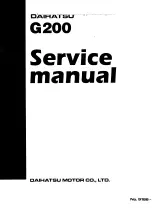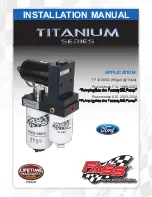
The cylinder head is of crossflow design
with the inlet manifold mounted on the left-
hand side and the exhaust manifold mounted
on the right-hand side.
Lubrication is by means of a bi-rotor pump
which draws oil through a strainer located
inside the sump, and forces it through a full-
flow filter into the engine oil galleries where it
is distributed to the crankshaft, camshaft and
auxiliary shaft. The big-end bearings are
supplied with oil via internal drillings in the
crankshaft. The undersides of the pistons are
supplied with oil from drillings in the big-ends.
The distributor shaft is intermittently supplied
with oil from the drilled auxiliary shaft. The
camshaft and cam followers are supplied with
oil via a drilled spray tube from the centre
camshaft bearing.
A semi-closed crankcase ventilation system
is employed whereby piston blow-by gases
are drawn into the inlet manifold via an oil
separator and on carburettor models a control
valve.
The following operations can be carried out
without removing the engine, although the
work may be easier and quicker with the
engine removed:
a)
Removal and refitting of the cylinder head
b)
Removal and refitting of the camshaft
(after removing the cylinder head)
c)
Removal and refitting of the timing belt
and sprockets
d)
Removal and refitting of the sump and oil
pump
e)
Removal and refitting of the pistons,
connecting rods and big-end bearings
f)
Renewal of the engine mountings
g)
Renewal of the crankshaft oil seals
h)
Removal and refitting of the auxiliary shaft
j)Removal and refitting of the flywheel
The engine must be removed from the
vehicle for the following operations:
a) Renewal of the crankshaft main bearings
b) Removal and refitting of the crankshaft
The engine may be lifted out either on its
own or together with the gearbox. Unless work
is also necessary on the gearbox it is
recommended that the engine is removed on
its own. Where automatic transmission is
fitted, the engine should be removed on its
own owing to the additional weight. If the
engine and gearbox are removed together,
they will have to be tilted at a very steep angle;
make sure that the range of the lifting tackle is
adequate.
1 Disconnect the battery negative lead.
2 Remove the bonnet.
3 On carburettor models, remove the air
cleaner. On fuel-injection models, remove the
air cleaner cover, vane airflow meter and air
inlet trunking.
4 If a splash guard is fitted, remove it.
5 Release the securing clips and bolts and
remove the upper half of the fan shroud. On
carburettor models remove the lower half of
the shroud too.
6 Drain the cooling system.
7 Disconnect the radiator top and bottom
hoses from the thermostat housing and water
pump. Disconnect the top hose spur from the
expansion tank and unclip it.
8 Disconnect the heater hoses from the water
pump and from the inlet manifold or automatic
choke housing. Unclip the hoses.
9 On models with power steering, remove the
steering pump.
10 Disconnect the vacuum pipe(s) from the
inlet manifold, labelling them if there is any
possibility of confusion.
11 Disconnect the following wiring, as
applicable:
a)
Alternator
b)
Temperature gauge sender
c)
Engine management temperature sensor
d)
Distributor
e)
Oil pressure switch
f)
Automatic choke and thermo-switch
g)
Carburettor stepper motor
h)
Fuel-injection system sub-harness
j)
Inlet manifold heater
12 Disconnect the HT lead from the coil.
13 If an oil level sensor is fitted, remove it
(see illustration).
14 Unbolt the throttle cable bracket,
disconnect the inner cable and move the cable
and bracket aside. Also disconnect the
downshift cable on automatic transmission
models.
15 On carburettor models, disconnect the
fuel lines from the fuel pump (mechanised
type) and from the carburettor. Be prepared
for fuel spillage.
16 On fuel-injection models, disconnect the
fuel supply union from the injector rail, and the
fuel return pipe from the fuel pressure
regulator. Be prepared for fuel spillage, and
for some spray if the supply side is still
under pressure.
17 Unbolt the exhaust downpipe from the
manifold.
18 On models with air conditioning, unbolt
the compressor and move it aside without
straining the flexible hoses.
19 Remove the starter motor.
20 Although not specified by the
manufacturers, the author advises that either
the radiator or the cooling fan be removed, to
reduce the risk of damage.
21 Attach the lifting tackle to the two lifting
eyes on the engine, so that when suspended
the engine will be roughly horizontal. Take the
weight of the engine.
22 Remove the single nut on each side which
secures each engine bearer to its mounting.
23 Working under the vehicle, remove the
bracing strap which connects the engine and
transmission. Unbolt the adapter plate from
the bottom of the transmission bellhousing.
24 On automatic transmission models, unbolt
the torque converter from the driveplate.
25 Remove the engine-to-bellhousing bolts.
Note the location of the battery earth strap.
26 Support the transmission, preferably with
a trolley jack.
27 Check that nothing has been overlooked,
then raise the engine and draw it forwards
clear of the transmission input shaft. Do not
allow the weight of the engine to hang on the
shaft, and do not lift the transmission by it.
28 On automatic transmission models, make
sure that the torque converter stays engaged
with the oil pump in the transmission as the
engine is withdrawn,
29 Lift the engine out of the engine bay and
take it to the bench.
1 Engine removal with automatic transmission
is not recommended.
2 Proceed as in the previous Section,
paragraphs 1 to 18.
3 Disconnect the wiring from the starter
motor, and release the battery earth cable
from its bellhousing bolt.
4 Remove the radiator.
5 Remove the propeller shaft.
6 Disconnect and unclip the reversing light
switch and speedometer sender unit wiring.
7 Disconnect the clutch cable.
8 Unbolt the anti-roll bar mounting brackets
and lower the anti-roll bar as far as possible.
9 From inside the vehicle remove the gear
lever.
10 Drain the engine oil.
11 Unhook the exhaust system from its
mounting on the gearbox crossmember. Either
support the system or remove it completely.
12 Support the gearbox, preferably with a
trolley jack, then unbolt and remove the
gearbox crossmember. Note the earth strap (if
fitted) under one of the crossmember bolts.
13 Attach lifting tackle to the two lifting eyes
on the engine so that when suspended it will
be at an angle of approximately 45°.
6 Engine - removal with manual
gearbox
5 Engine - removal leaving
gearbox/transmission in vehicle
4 Methods of engine removal
3 Major operations requiring
engine removal
2 Major operations possible with
the engine in the vehicle
SOHC engines 2A•5
2A
5.13 Oil level sensor
Содержание Granada 1985-1994
Страница 42: ...1 22 Notes...
Страница 102: ...2C 22 Notes...
Страница 136: ...4 24 Notes...
Страница 176: ...11 14 Notes...
Страница 196: ...12 20 Notes...
Страница 221: ...Wiring diagrams WD 1 WD Diagram 16 Power operated sliding roof...
Страница 222: ...WD 2 Wiring diagrams Diagram 2 Power distribution...
Страница 223: ...Wiring diagrams WD 3 WD Diagram 2 Power distribution continued...
Страница 224: ...WD 4 Wiring diagrams Diagram 3 Charge start and run Part 1...
Страница 225: ...Wiring diagrams WD 5 WD Diagram 3 Charge start and run Part 1 continued...
Страница 226: ...WD 6 Wiring diagrams Diagram 3A Charge start and run Part 2...
Страница 227: ...Wiring diagrams WD 7 WD Diagram 3A Charge start and run Part 2 continued...
Страница 228: ...WD 8 Wiring diagrams Diagram 4 Engine management 1 8 litre...
Страница 229: ...Wiring diagrams WD 9 WD Diagram 4 Engine management 1 8 litre continued...
Страница 230: ...WD 10 Wiring diagrams Diagram 4A Engine management 2 0 litre carburettor...
Страница 231: ...Wiring diagrams WD 11 WD Diagram 4A Engine management 2 0 litre carburettor continued...
Страница 232: ...WD 12 Wiring diagrams Diagram 5 Engine management 2 0 litre fuel injection...
Страница 233: ...Wiring diagrams WD 13 WD Diagram 5 Engine management 2 0 litre fuel injection continued...
Страница 234: ...WD 14 Wiring diagrams Diagram 5C Engine management 2 8 litre...
Страница 235: ...Wiring diagrams WD 15 WD Diagram 5C Engine management 2 8 litre continued...
Страница 236: ...WD 16 Wiring diagrams Diagram 7A Exterior lighting...
Страница 237: ...Wiring diagrams WD 17 WD Diagram 7A Exterior lighting continued...
Страница 238: ...WD 18 Wiring diagrams Diagram 9 Signalling and warning systems...
Страница 239: ...Wiring diagrams WD 19 WD Diagram 9 Signalling and warning systems continued...
Страница 240: ...WD 20 Wiring diagrams Diagram 10 Interior lighting...
Страница 241: ...Wiring diagrams WD 21 WD Diagram 10 Interior lighting continued...
Страница 242: ...WD 22 Wiring diagrams Diagram 12 Wipers and washers...
Страница 243: ...Wiring diagrams WD 23 WD Diagram 12 Wipers and washers continued...
Страница 244: ...WD 24 Wiring diagrams Diagram 14 Central locking system...
Страница 245: ...Wiring diagrams WD 25 WD Diagram 14 Central locking system continued...
Страница 246: ...WD 26 Wiring diagrams Diagram 15 Power operated windows...
Страница 247: ...Wiring diagrams WD 27 WD Diagram 15 Power operated windows continued...
Страница 248: ...WD 28 Wiring diagrams Diagram 21 ABS...
Страница 249: ...Wiring diagrams WD 29 WD Diagram 21 ABS continued...
Страница 250: ...WD 30 Wiring diagrams Diagram 23 Auxiliary warning system...
Страница 251: ...Wiring diagrams WD 31 WD Diagram 23 Auxiliary warning system continued...
Страница 252: ...WD 32 Wiring diagrams Diagram 29 Radio cassette player and associated circuits typical...
Страница 253: ...Wiring diagrams WD 33 WD Diagram 29 Radio cassette player and associated circuits typical continued...
Страница 254: ...WD 34 Wiring diagrams Diagram 11 Heater blower...
















































